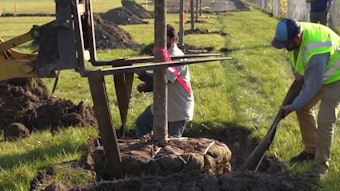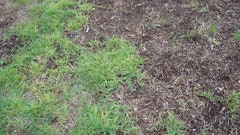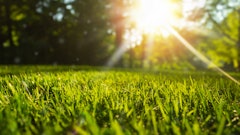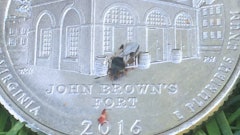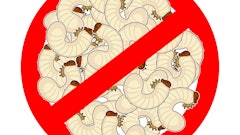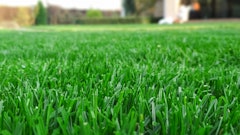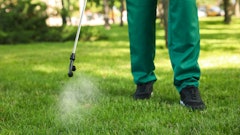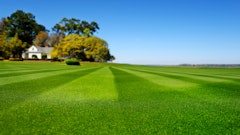
As winter approaches, once-vibrant lawns transition into a dormant landscape, sometimes hidden beneath frost and snow. Including soggy soil, fallen leaves, biting cold, elusive voles and winter desiccation, winter turfgrass faces various obstacles. In this guide, we will explore these common problems and provide solutions to help you maintain a healthy lawn throughout the winter season.
Key winter lawn care practices
Even though a lawn may appear dormant, it remains alive and has specific needs, such as sufficient moisture. Winter lawn care is just as vital as other seasonal maintenance routines since the care you provide now will significantly impact a lawn's reawakening in spring. Here are some essential care tips:
- Mowing (if it's still actively growing)
- Watering
- Weeding
Pro tip: Fertilization is best done during active growing seasons like spring, summer and fall. Avoid applying fertilizer once temperatures consistently drop below 40 degrees Fahrenheit, as it won't be as effective. Prepare a lawn with the necessary nutrients during the fall to ensure it survives winter dormancy.
Problem No. 1: Wet soil
Problem: In winter, lawns often struggle with soggy soil due to increased precipitation and frozen ground's poor moisture absorption. This excess water can cause compaction, reduce root oxygen and invite fungal diseases.
Solutions:
- Aerating the lawn: This practice perforates the soil, improving water infiltration and root oxygenation.
- Installing French drains: These drains help redirect excess water, preventing waterlogging.
Prevention:
- Ensure proper grading and drainage to direct water away from low-lying areas.
- Regularly aerate the lawn to enhance soil structure and water infiltration.
- Promptly rake and remove fallen leaves to prevent water buildup.
Problem No. 2: Fallen leaves and debris
Problem: Fallen leaves, initially innocuous, can harm a winter lawn. They create a moisture-trapping barrier, promote fungal diseases and block sunlight and air circulation, hindering photosynthesis and grass growth.
Solutions:
- Regularly rake to prevent leaf buildup, ensuring sunlight and air reach the grass.
- Alternatively, mulch the leaves with a mower to provide an eco-friendly solution.
Pro tip: Leaving some of autumn's fallen leaves on the ground benefits wildlife, enhances soil fertility and reduces weeds. It also provides habitat for various creatures, aiding pest control and pollination.
Prevention:
- Regularly prune and trim trees to reduce the number of fallen leaves.
- Consider installing leaf-catching screens or barriers around trees and gutters.
Problem No. 3: Cold temperatures
Problem: Winter's freezing temperatures can harm lawns, making grass brittle and vulnerable to damage. Freeze-thaw cycles lead to soil heaving, exposing roots and causing desiccation or winterkill.
Prevention:
- Choose cold-hardy grass varieties suited to a region's climate.
- Ensure the lawn is well-fertilized and hydrated before winter.
- Avoid excessive foot traffic on frozen grass and insulate sensitive plants with mulch or protective covers.
Problem No. 4: Pesky voles
Problem: Winter voles wreak havoc on lawns, tunneling beneath snow to feed on roots and cause damage.
Solutions:
- Trapping with mousetraps or live traps baited with peanut butter or apple slices.
- Installing hardware cloth or underground fencing.
- Using castor oil-based repellents or ultrasonic-powered vole repellent stakes.
- Keeping vegetation short in the fall and clearing snow away from lawn edges.
Prevention:
- Maintain a well-groomed lawn.
- Reduce potential vole food sources.
- Create an environment less hospitable to voles.
Problem No. 5: Crown hydration
Problem: Crown hydration occurs when soil briefly thaws, causing grass crowns to absorb water. Subsequent freezing damages cells, weakening grass and potentially causing brown patches or death.
Solutions:
- Detect crown hydration damage in winter grass by watching for symptoms like delayed greening, thinning, stunted growth, dead patches and weak roots.
- Gently remove dead grass and thatch for improved air circulation and growth stimulation.
- Reseed or use grass plugs in damaged areas in spring.
- Apply balanced fertilizer for recovery without excess nitrogen.
Prevention:
- Maintain soil drainage.
- Avoid excessive pre-winter watering.
- Choose cold-hardy grass and reduce soil compaction through aeration.
Problem No. 6: Winter desiccation
Problem: Winter desiccation, or "winter burn," occurs due to dehydration during winter, caused by freezing temperatures, harsh winds and low humidity. It leads to browning, brittleness and potential damage.
Solutions:
- Water during thaw periods and mild winter days to restore moisture.
- Apply light mulch or straw where snowfall is insufficient to protect against moisture loss.
- Trim overhanging branches and remove debris blocking sunlight and airflow.
- Minimize deicing chemicals/salt use on walkways and driveways.
- Overseed damaged areas, fertilize, aerate and dethatch for healthy regrowth.
Prevention:
- Deeply water the lawn before freezing to ensure sufficient moisture.
- Keep the lawn clear of leaves and debris.
- Apply antitranspirants to reduce water loss from leaves.
- Hope for prolonged snow coverage, which provides insulation and moisture.
How to protect grass in winter, answered
In conclusion, winter presents unique challenges for lawn care. However, proactive winter grass care is essential for a healthy spring revival. Implementing practical prevention techniques such as choosing suitable grass varieties, avoiding excessive foot traffic, ensuring proper fertilization and hydration, averting issues with wet soil, minimizing fallen leaves, deterring troublesome voles and vigilantly monitoring for crown hydration and winter desiccation can yield substantial benefits.
Use these tips to proactively prepare a lawn for winter, and it will reward you with a lush and healthy appearance come spring. Take action now to protect the lawn from the challenges of the winter season and enjoy a beautiful landscape all year round.

